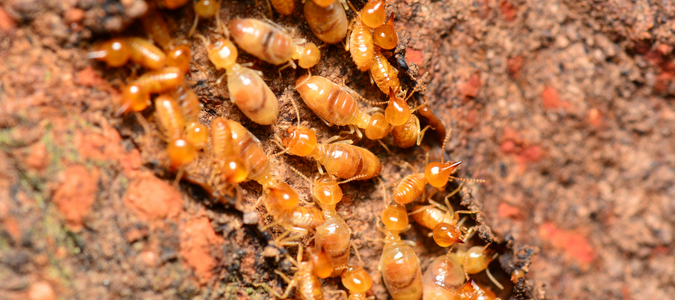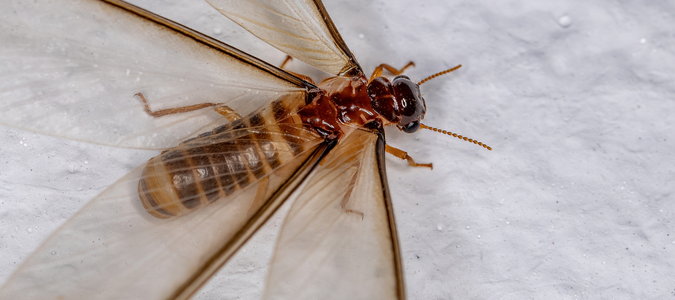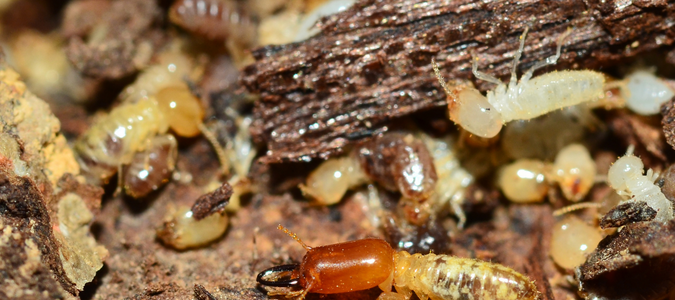Termites are an expensive problem to have at home. They can destroy almost anything, including wooden structures, insulation, books and filtration systems. Even the plants and trees in your backyard aren’t safe from these pests. They’re hard workers, wreaking havoc all year round. The needed repairs can leave a gaping hole in homeowners’ wallets.
While termites are common household pests, you might be surprised to see red variants invading your home. These are most likely drywood termite swarmers. It helps to know more about their characteristics and habits so you can identify them and control them.
Of course, you’ll need the help of pest control specialists. They have the tools and expertise to control termites and restore peace and comfort. It’s better to contact them sooner rather than later to prevent damage to your home.
Do Red Termites Exist?
We may not know it, but termites are all over the world. There are around 2,600 species of these pests, and they’re thriving because of their unique gut system. With millions of microorganisms in their stomachs, they can digest wood, paper, soil and other materials, turning them into protein and sugar. These aren’t typical food sources for other animals.
We can find three main species in the United States. These are drywood, dampwood and subterranean termites. Looking at their colors and other traits will help you determine which is which. If you’re seeing red termites in and around your home, those are most likely drywood termite swarmers. However, drywood termite swarmers come in a rainbow of colors. Aside from red, they can also be pale tan and dark brown.
What You Should Know About Drywood Termites
Drywood termites come in various hues, from tan to dark brown. Their bodies are long and narrow, usually three-eighths of an inch to one inch long. Like other insects, they have six legs and a pair of antennae.
As their name implies, they thrive inside dry and hardwood in our homes instead of making colonies underground. Unlike subterranean termites, they don’t need the soil’s dampness to survive. The wood they consume provides them with the moisture they need. They’ll live in wooden structures, furniture and picture frames, making them just as destructive as other species.
Unfortunately for homeowners, drywood termite infestations aren’t always easy to detect. These stealthy pests live deep inside their wooden dwellings. You’ll usually never see them out unless it’s their swarming period or renovations are happening in your home. In addition, their colonies are small in comparison to other species, usually consisting of no more than a thousand termites. These colonies can also take years to mature and become noticeable.
If you spot drywood termites on your property, they’re most likely flying adults or swarmers. These reproductive termites fly away to find a mate and make their own colonies. Swarming happens during the day, usually in the spring and fall. Seeing swarmers emerge from tiny holes in wooden objects signals an infestation. Here are other signs to look out for.
- Blistering. When you spot “bubbling” on wood, that might be termites tunneling too close to the outer layer.
- Kick-out holes. Termites use these openings to discard their droppings.
- Droppings. You might spot hexagon-shaped fecal pellets accumulating on the ground below the kick-out holes. They’ll be the same color as the wood the termites are consuming.
While homeowners may come upon swarmers and other signs of termites, it’s nearly impossible to know the extent of an infestation without a professional’s help. When pest control experts conduct home inspections, they search for material damage, kick-out holes, fallen wings and fecal pellets. They can then determine if the infestation is active and how large it is before working to control it.
How Are Red Termites With Wings Different?
Red termites look menacing, even more so when they have wings. But these are just drywood termite swarmers. You can identify them by their transparent or light gray wings. They have two pairs, the first set marked by pigmented veins. Aside from red, they can sport light and dark brown colors. So, how are swarmers different from the rest of their colonies?
Drywood termites follow a caste system. Once a queen finds a suitable home to settle down in, she’ll mate and lay eggs. That’s the start of an infestation inside a home. As the colony ages, some termites become workers and soldiers while others develop into reproductive adults called swarmers.
The soldier termites will stay with the colony to protect it from enemy ants and other predators. As for the workers, it’s their job to groom the queen, make tunnels, clean the nest and feed the other castes. Meanwhile, the swarmers will develop wings and leave their home. They’ll mate and build colonies elsewhere. They swarm in the daytime during spring and fall. After swarming, they’ll quickly shed their wings and won’t regrow new ones.
Like other termite species, drywood termites can cause significant damage to a home. They eat across the wood grain, which can lead to structural damage once their tunnels get too large. And unlike fires and natural disasters, insurance policies don’t usually cover termite damage.
The best way to prevent expensive repairs is by scheduling regular inspections with pest control professionals who know what termites look like. They can sniff out hidden termite colonies and prevent them from growing bigger and unleashing havoc in your home.
How Do Termites Build Their Colonies?
Life inside a termite colony is slow, especially for the first two years of its existence. New colonies start with a queen, her chosen king, a few nymphs and perhaps one soldier. The queen takes her time to settle into her role and will use the next seven to ten years to produce eggs.
In a year, the number of nymphs can range between 50 to 900, and there can be as many as eight soldiers. The colony will develop a caste system, producing soldiers, workers and swarmers. While that’s the general makeup of a colony, every termite species has its own way of running things.
Subterranean Termite Colonies
Subterranean termites are the most common species in the United States. They love the dampness and coolness of the soil and will make homes for themselves deep beneath the ground. There, they get the humidity they need to survive. Subterranean colonies are massive, usually consisting of 600,000 to a million termites.
These termites reside in a complex network of tunnels, raising their young and storing food in tiny rooms. They will keep expanding their territory and may eventually intermingle with another colony. That means two different colonies can infest one house.
Subterranean termites live on cellulose found in wood. Door frames, deck posts and stairs that touch the ground give them easy access to food. They can also devour the wood in your home by entering cracks in the foundation. They might even build mud tubes to help workers reach food sources inside.
Drywood Termite Colonies
Drywood termite colonies aren’t as massive as their subterranean counterparts. Their maximum colony size is 4,800 to 5,000 termites. And instead of tunneling underground, they use dry wood as their home, making no contact with soil. They get all the moisture and nutrients they need from their wooden habitats.
They usually start by invading the dead trees and fallen logs around your property. Once ready to expand their colony, they’ll move on to wooden structures and furniture inside your home. Another unique thing about drywood termite colonies is that they don’t have an official working caste. The nymphs take on the role of the workers, serving the queen and feeding the colony.
Dampwood Termite Colonies
Dampwood termite colonies live in damp, sometimes very wet environments. The ideal home for them is usually moist wood in basements and crawl spaces. These areas have high humidity levels, which helps them thrive. They keep their living areas moist by sealing holes in the wood with their feces.
They have lots of similarities with their drywood cousins. Their colonies are small. They also live deep inside wood and use it for food. In addition, they don’t have a designated worker caste, with the nymphs doing all the chores.
Formosan Termite Colonies
Formosan termites are a subterranean species that have found their way to the southeastern areas of the United States. Their colony sizes range from 350,000 to two million termites. Although they live underground, they can enter homes through structural parts that touch the ground.
Formosan termites have an interesting capability. Their winged swarmers can create an aerial colony if there’s a suitable spot with sufficient food and water. A flat roof that accumulates rain is a prime example.
Having Termite Troubles? Contact the Pros
Termite control is beyond the DIY skills of homeowners. If a termite colony is taking over your property, let pest control experts handle it. They know how to return your home to its tranquil state.
ABC Can Help With Pest Infestations of Any Kind
Finding red termites in and around your property can be extremely concerning. These pests are destructive and their colonies can hold thousands of members. If you suspect termites on your property, contact ABC Home & Commercial Services. Our professionals will be able to locate the termite colony and then implement an effective termite control plan.


